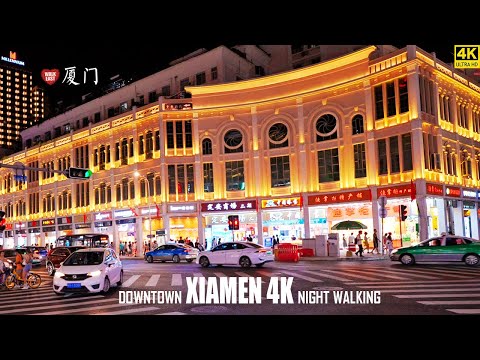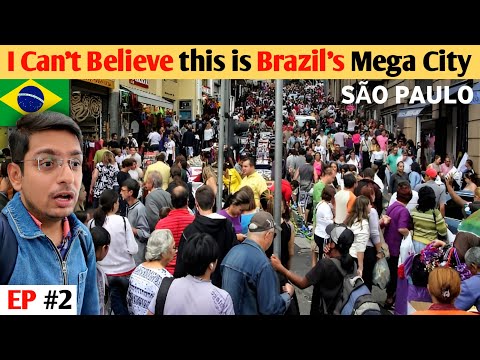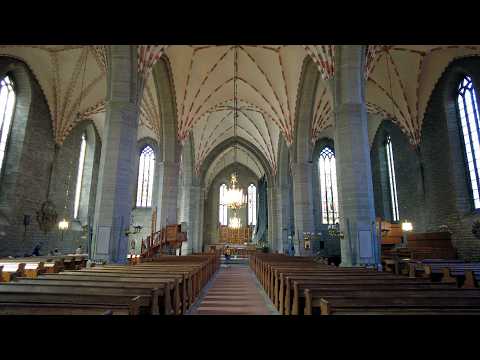Xiamen Night Walk | The Pedestrian Street & Night Food Alleys | 4K HDR | Fujian | 厦门 | 中山路步行街 | 曾厝垵

Zhongshan street is the nerve centre of Xiamen tourism. All tourists, travellers, visitors, how you may prefer to call them, they all come here at some point of their visit. It is said that more than a billion people pass here every year. More than a billion! Now you would wonder who these people are and where they all come from? Well, firstly, they aren’t foreigners. They are local Chinese tourists from other regions in China. Secondly, in this trip to Xiamen, I realised that China is seriously an economic power to reckon with.
They do not need foreigners to augment their tourism sector. They are self-sufficient because millions of Chinese are out there travelling locally. Zhongshan Road is the oldest commercial street in Xiamen dating back to 1925. It is a kilometre long walking street filled with pretty retail shops, big department stores, lots of cute cafes and contemporary and traditional cuisine restaurants, food courts and more retail shops.
It is closed to any vehicular traffic and smoking is not allowed on the streets. Visiting this street is a must for Xiamen first time visitors. Some may find this street too touristy, highly commercialised, loud and nothing special at all, whilst another will probably think it is great and lively, and a good representation where the now capitalist China is heading for. Western and traditional shops collide here at Zhongshan; yes, there is a KFC and McDonalds and the interior design of many tea shops, such as the elegant Miss Zhao will make you think you are in one of the exclusive stores in Europe. There are tea stores here selling the traditional loose leaf tea and others that are trendy, a combination of a tea shop and a cafe promoting milk tea and pearl milk tea. Zhang Sanfeng Milk Tea Shop is one of the popular ones.
There is a wide array of local food delights as well which are perfect to bring home as souvenirs and gifts, such as dried food products (crab, squid, fish, pork floss), nuts, durian, pineapple and mango candies, mooncakes of different flavours, roast duck and more. Many promotional ladies stand outside the shops as well and beg passersby to taste a sample of their product. I managed to taste some of the dried seafood and mooncakes and ended up buying a few packs as homecoming gifts for my family. There is also a very interesting street food scene here. The Fujian-style snacks which has a focus on seafood and right up my alley as I love anything coming from the sea. I will be writing a separate post about this very soon.
Except for food, I am not a big retail shopper but there is plenty of department stores here for people looking for clothes, shoes and other dry personal and home goods. And oh, for the ladies, many jewellery shops here would chain you a necklace made of pearls harvested from a live oyster right before your eyes. While you wait. Being the heartland of Xiamen’s commercial area, Zhongshan Road Pedestrian Street covers a total area of one million square meters and takes up nearly one third of the total business area of Xiamen. This is a beautiful and prosperous commercial corridor where you can find the serried ranks rows of stores with a dense crowd.
The Zhongshan Road Pedestrian Street was founded in 1925. The name of the street was changed to “Da han Road” during the Puppet Governed by Japan. The Zhongshan Pedestrian Street was changed into “Dongfanghong Road” in 1966 and back to Xiamen Zhongshan Road in October of year 1979. Zhongshan Road Pedestrian Street became a prosperous Commercial Street since 1959. In 2004, the west section of Zhongshan Road was designated as the pedestrian area where motor vehicles were banned. Since then, the pedestrian flow has greatly increased.
In 2005, the number of passing-by people in Zhongshan Road was up to 1.1 billion a year. The Zhongshan Road Pedestrian Street is 1198 meters long and 15 meters wide. Most of the buildings along the street were constructed by the returned overseas Chinese in 1920s. Influenced by the architecture style of Western Sea area, most of the buildings have the type of British except a few with France and German flavor. When you are walking around the street, you can not only feel the intense competition of the market economy, but also can taste the fresh aroma of the socialistic civilization. The Qilou Street of Zhongshan Road is the representative of architecture culture of Xiamen City.
“Qilou Street” means the street is under buildings. This kind of architecture which takes pink and ivory-white as the main hue has a strong exotic flavor of South Seas area. Strolling in Zhongshan Road, you can feel the vitality and the vigor which were exploded by competitions and all merchants are trying their best to fit the intense competition. All the merchants around the street have promoted a series of service projects aiming for keeping business rules, good mannered and offering the conveniences and advantages to citizens. Many shops and stores are awarded as good-mannered units or trusted enterprises at the district, municipal or provincial levels.
The activities of being a “Good Street” and “Non Fakes Shop” promote a good environment for trading and business to the Zhongshan Road Pedestrian Street. Xiamen is a coastal city in Fujian Province in China. It has been an important port for centuries and became one of China's earliest Special Economic Zones in the 1980s. The name Xiamen means "door to the house", referring to the city's centuries-old role as a gateway to China.
It is not Taipei or Hong Kong, but compared to most other cities in the region, Xiamen is definitely a very vibrant, affluent and modern place. It got an international award in a contest for most livable cities in 2002; neighboring Quanzhou won the following year. The most important tourist area is Gulangyu Island, a small island which contains some beautiful colonial buildings and is car free. A tourist to Xiamen easily realizes he has entered Zengcuoan when walking along the southern coast of the island city. Although the place is not prominent on the map, Zengcuoan draws seas of tourists with its artistic-style inns, local foods and all sorts of creative products. Its name literally means "the village of the Zeng family".
Zengcuoan was just a small fishing village five years ago, but now it is bustling with commerce. Along the many narrow alleys winding up and down, paved with stone, are around 700 shops, restaurants and inns. A must-try local snack is called tusundong, or sea worm jelly.
The worms are boiled and then cooled to make jelly. Before eating, people add many seasonings such as soy source, vinegar, chili, mustard and garlic. The area is as busy in the evening as in the day. At the sunset hour, the fading halo of the sun drops on the quiet beach as just a few meters away the alleys of Zengcuoan still bustle with tourists from across the world enjoying their coffee, cakes and seafood barbecue. Like many resorts across the world, shop owners keep smiling to welcome new guests. While some tourists choose quick tours because of tight schedules, most prefer to enjoy taking it slow, staying in a local inn for days to try all local foods, buy handicrafts or just to enjoy the view.
A freelance travel blog writer surnamed Chen said he stayed in Zengcuoan for two days. "Sometimes I just sit under a palm tree on the nearby beach doing nothing but looking at the sea and enjoying the breeze," he said. "Zengcuoan is attractive to college students and young travelers with an artistic temperament," said Jiang Yuan, a student at Xiamen University whose dormitory is in the area. She said that nearly every student at Xiamen University has been to a local inn called Dreamer House where concerts and parties are often organized.
2021-07-10 05:26


